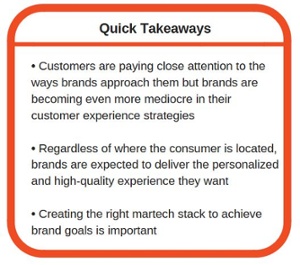 The global marketing technology industry is growing rapidly, and it’s not expected to slow down any time soon. According to a recent report from Moore Stephens and Warc, firms in North America and the U.K. increased their martech investments by 44 percent last year. It’s no surprise why – brands are under pressure to fix the broken customer experience gap, and martech is the missing piece.
The global marketing technology industry is growing rapidly, and it’s not expected to slow down any time soon. According to a recent report from Moore Stephens and Warc, firms in North America and the U.K. increased their martech investments by 44 percent last year. It’s no surprise why – brands are under pressure to fix the broken customer experience gap, and martech is the missing piece.
Let’s be honest. The customer experience some brands deliver is consistently lacking. Customers aren’t ignoring these sub-par experiences either. Forrester’s 2018 Customer Experience Index for US Brands revealed that customers are paying close attention to the ways brands approach them. Unfortunately for marketers, the overall consensus among U.S. adult customers is that brands are becoming even more mediocre in their customer experience strategies.
Marketers need to fix their broken customer experience programs and win customers over, before they lose them forever. With the right marketing technology, brands can bridge the customer experience gap and deliver the type of content and service today’s customers expect. Benefits for marketers include:

1. Gaining a 360-Degree View of the Customer
Creating the right martech stack to achieve brand goals is important, but it’s even more important to make sure the technologies within the stack communicate with each other. Marketers have more than 6,800 martech solutions to choose from, which means they’re working with a lot of different channels, systems and data. These all touch a variety of departments too, including marketing, customer service, advertising, sales and more.
 While these tools all work individually on their own, they need to talk to each other to be effective. When systems are aligned and customer data is the same across every platform and department, marketers gain a comprehensive 360-degree view of the customer. With insight into every historical touchpoint, marketers can better understand what their next engagement should look like. This helps the customer journey flow seamlessly and shows customers that the brand understands what they want, ultimately leading to a better customer experience.
While these tools all work individually on their own, they need to talk to each other to be effective. When systems are aligned and customer data is the same across every platform and department, marketers gain a comprehensive 360-degree view of the customer. With insight into every historical touchpoint, marketers can better understand what their next engagement should look like. This helps the customer journey flow seamlessly and shows customers that the brand understands what they want, ultimately leading to a better customer experience.
2. Leveraging Individual Insights for Personalization
While visitor characteristics like location are useful to collect for anonymous visitors, marketers need to get more sophisticated for known visitor profiles. At this point in the journey, brands really need to understand what the visitor wants. For example, marketers should look at what type of content they engage with, what product seems to be their favorite, and what gets them to convert. This is the most important information a marketer can collect and provides them with the insight they need to deliver the most relevant experience to the right person.
 3. Creating B2B Loyalty and Engagement Anywhere, Anytime
3. Creating B2B Loyalty and Engagement Anywhere, Anytime
In today’s world, B2B customers expect the same customer experience B2C customers receive across any device. Customer loyalty strategies should no longer be reserved for B2C buyers – B2B purchasers want this too. For example, wholesale medical supplies and equipment distributors supply hospitals with the tools they need to deliver superior patient care. However, the hospital decision makers are often responsible for choosing the equipment for multiple branches, locations and facilities of the medical group. As they browse the latest products that are available on the distributor’s website, marketers need to pay attention. This is an opportunity to sell to more than just one location. To entice the browser to purchase, the marketer can share an email coupon after the initial interest is shown. It’s now more likely the site visitors will seriously consider making a purchase for multiple locations – and be able to tell their own boss that they got a discount. Regardless of where the consumer is located, brands are expected to deliver the personalized and high-quality experience they want.
As brands approach the end of the year, they’re beginning to think about what’s on the horizon for 2019. Many prospects and buyers found their experiences with brands to be disappointing in 2018, so it’s time for marketers to up-level their strategies. Investing in the right martech solutions, and ensuring those solutions are communicating, can help them reach their goals.
Are you delivering the experience you know your customers deserve? If you want to engage today’s consumers with the rich, compelling, personalized content they expect, find out how we can help.

 3. Creating B2B Loyalty and Engagement Anywhere, Anytime
3. Creating B2B Loyalty and Engagement Anywhere, Anytime
